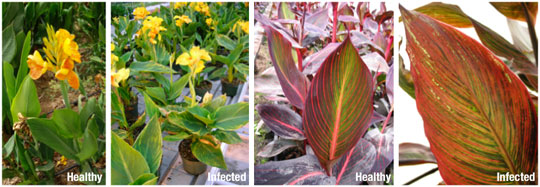9/30/2015
Viruses in Cannas—Past, Present and Future
Silit Lazare
Canna’s virus disease was first reported in the early 2000s. The infectious viruses were spread epidemically all over the globe, collapsing the market of this important ornamental crop. The symptoms were quite similar in all countries—distorted, curled-up leaves, yellow strikes and spots, and early wilting of the plant. The first infected stocks were found in Europe, but soon it became clear that the disease spread everywhere.
There are five known viruses that infect canna, but only two of them seem to have significant effect on the plant’s health and performance. These are Canna yellow streak virus (CaYSV) and Canna yellow mottle virus (CaYMV). The viruses have different performances in green-leaf, dark-leaf and striped cultivars. Here are some descriptions, which can help growers recognize and avoid these diseases (note that some of the described symptoms may refer to physiological stress, pesticide toxicity or nutrition disorders):
• In green or dark-leaf cultivars: Pale streaks along the leaf veins or pale spots over the blade.
• In striped cultivars, it’s a bit more difficult, but healthy plants show a clear, bright and steady pattern of narrow stripes, while the infected leaves have a matte and messy pattern, made of wide, irregular stripes and spots.
• The first leaf from an infected rhizome will already have the symptoms, even before full unfolding.
As virus diseases are common in floriculture, the journey to heal the cannas began with studying them. We read books and articles, spoke with growers and researchers all over the world and visited nurseries that are experts in virus-free stocks of bedding plants in order to find the best way to cope with this challenge and establish virus-free stock.
As there’s no way to cure virus-infected plants, our primary mission was to find a healthy source to begin with. We sought healthy plants in order to propagate them under high sanitary conditions and tested samples from many long-standing gardens, but it seemed that there are no clean and healthy canna plants! Even good-looking material tested positive of the viruses in the laboratory. This fact was quite frustrating, as you can imagine.
Finally, we decided to clean an infected plant. This was a long track of trial and error in collaboration with expert virologists. Many techniques were tested; some were false, some were better, but not enough. There were many deceptions, as tissue culture propagation includes hormones that sometimes falsify the virus tests and samples that were tested negative as plantlets grew and were found to be virus positive when tested as mature plants. At last, the scientific miracle happened, and we had a virus-free canna plant in our hands.
This was the first and most difficult step. Our next mission was to keep it healthy and establish virus-free stock. Now we could use all the information we collected earlier and build a growth system that suits the unique plant material we have.
The virus-free material is propagated by tissue culture (TC). The plantlets are grown in nuclear and foundation stocks, in a sterile environment, and are tested regularly in a laboratory. We let the plants flower at least once in each season in order to ensure it’s true to type. One commercial route includes TC plantlets that are propagated each year from the nuclear stock. Another route is the dry-sell one—here, we propagate the foundation stock and grow the plants in an isolated field at the desert, away from other agricultural crops.
Canna disease re-infection may occur during mass production in open fields, since it’s not a sterile environment. Taking into account that the plants start this stage as virus-free, we know that there will probably be a slight infection without characteristic symptoms.
Re-infection may also occur by the wrong treatment in the garden. A grower must exterminate old canna plants before planting the new ones and handle the rhizomes with care in order to keep them injury-free.
Our vision became reality—floriculture got its cannas back. If we grow them carefully, we can enjoy their lovely foliage and blooms for days to come.
GT
 In green or dark-leaf cultivars, canna viruses show as pale streaks along the leaf veins or pale spots over the blade (right). A healthy specimen is on the left.
In green or dark-leaf cultivars, canna viruses show as pale streaks along the leaf veins or pale spots over the blade (right). A healthy specimen is on the left.
In striped cultivars, it’s a bit more difficult to detect disease, but healthy plants show a clear, bright and steady pattern of narrow stripes (left), while the infected leaves have a matte and messy pattern, made of wide, irregular stripes and spots (right).
Silit Lazare is an Agronomist with Saad-Assaf nurseries in Israel.